 The process of designing and implementing Communities as Resources in Early Childhood Teacher Education is grounded in design-based research. This blog will inform the research—and you—about our work. We intend our audience to be broad. We would like for the entire early childhood community (teachers, families, teacher educators, community members) to interact with us as we share our ongoing work with you. We would also like for teacher educators who are not in early childhood, but who are committed to field intensive, clinically based teacher education, to be a part of our audience.
The process of designing and implementing Communities as Resources in Early Childhood Teacher Education is grounded in design-based research. This blog will inform the research—and you—about our work. We intend our audience to be broad. We would like for the entire early childhood community (teachers, families, teacher educators, community members) to interact with us as we share our ongoing work with you. We would also like for teacher educators who are not in early childhood, but who are committed to field intensive, clinically based teacher education, to be a part of our audience.
Wherever possible, without violating confidentiality and without identifying individuals we will share our stories of working with one another to create CREATE. One year into the process we can tell you that our collaboration has been greatly improved by scheduling regular meetings, assigning specific roles and responsibilities, and monitoring our communication for intended and unintended messages with one another and with our school and community partners. We can also tell you that as we university-based educators learn to work more productively with one another we are becoming more and more aware of how the structure of our work and the structure of our school and community partners’ work greatly impact the nature of our collaborative work. In future blogs we will talk about things such as the ways issues of space are being resolved and the ways in which issues of time continue to perplex us. We will reflect on the curriculum and the professional development activities that you can see in other areas of this website. We will share our assessment and research processes.
Every two weeks one of the CREATE team members will post a blog that describes the challenges we are encountering, solutions we are testing, or dilemmas that have no obvious resolution. Our initial blogs will be university-focused, but our district and community partners will soon join the blogosphere to share their experiences, joys and concerns.
We would like to invite you into our process—to dialogue with us and help shape our work and our interpretations of that work. Please write back to us. Ask us questions. Offer us your insights. Share your own work. Become our co-CREATEors.
]]> The session we presented at the Literacy Research Association annual meeting in Jacksonville, Florida, “Communities as Resources in Early Childhood Teacher Education Enacting a New Vision of Early Childhood Literacy Education” in November marks what I think of as our first public presentation and discussion of our work. Prior to this session, we have primarily discussed CREATE with participants—district administrators and teachers, early childhood center staffs, students in the Early Childhood Education Program, our advisory board, and the Helios Foundation, our grantor.
The session we presented at the Literacy Research Association annual meeting in Jacksonville, Florida, “Communities as Resources in Early Childhood Teacher Education Enacting a New Vision of Early Childhood Literacy Education” in November marks what I think of as our first public presentation and discussion of our work. Prior to this session, we have primarily discussed CREATE with participants—district administrators and teachers, early childhood center staffs, students in the Early Childhood Education Program, our advisory board, and the Helios Foundation, our grantor.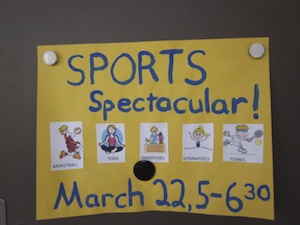
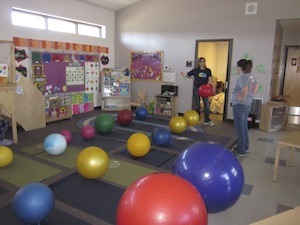
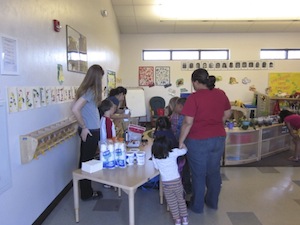 Kids from Emily’s Place and their families were invited to join in on the fun in classrooms and on the playground. Teachers from Emily’s Place along with student teachers from cohort 4 created activities that focused being active and eating healthy while literacy and math were woven in. They featured dancing, yoga, tumbling, tennis, basketball, a smoothie station, and even bicycle obstacle course.
Kids from Emily’s Place and their families were invited to join in on the fun in classrooms and on the playground. Teachers from Emily’s Place along with student teachers from cohort 4 created activities that focused being active and eating healthy while literacy and math were woven in. They featured dancing, yoga, tumbling, tennis, basketball, a smoothie station, and even bicycle obstacle course.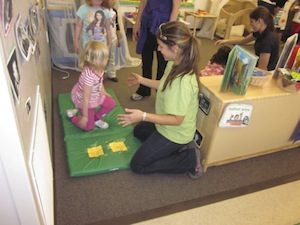 Everyone conducted a taste test that featured a berry-based smoothie versus a tropical fruit one. Families were then invited to create a recipe card so that they could recreate their treat at home. The idea behind the smoothie station was not only to create a tasty experience but also to remind us that including kids in cooking is often a great way to expose them to math and literacy in our every day life.
Everyone conducted a taste test that featured a berry-based smoothie versus a tropical fruit one. Families were then invited to create a recipe card so that they could recreate their treat at home. The idea behind the smoothie station was not only to create a tasty experience but also to remind us that including kids in cooking is often a great way to expose them to math and literacy in our every day life.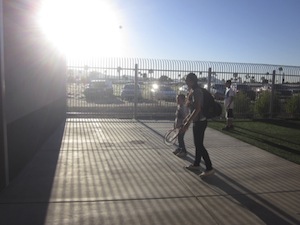 Families also explored yoga, tennis, dancing, and basketball that were hosted in classrooms and in communal spaces around the school. With the help of cohort 4 and 5 students, teachers from Emily’s Place were able to provide fun for all.
Families also explored yoga, tennis, dancing, and basketball that were hosted in classrooms and in communal spaces around the school. With the help of cohort 4 and 5 students, teachers from Emily’s Place were able to provide fun for all. The bicycle safety obstacle course was the next hot spot in the evening. Cohort 4 and 5 students along with teachers from Emily’s Place helped kids put on helmets before venturing out on the course. Along the route kids had to navigate hills, bridges, and of course a little traffic. At several different points along the route kids also came across various street signs such as yield and stop. Using signs helped kids understand their use for them and how they keep us safe while riding along with neighborhood traffic and although most kids on the course aren’t yet “readers” it encourages them to become aware and understand what might be on their own neighborhood streets.
The bicycle safety obstacle course was the next hot spot in the evening. Cohort 4 and 5 students along with teachers from Emily’s Place helped kids put on helmets before venturing out on the course. Along the route kids had to navigate hills, bridges, and of course a little traffic. At several different points along the route kids also came across various street signs such as yield and stop. Using signs helped kids understand their use for them and how they keep us safe while riding along with neighborhood traffic and although most kids on the course aren’t yet “readers” it encourages them to become aware and understand what might be on their own neighborhood streets.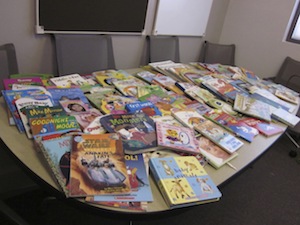 As families said goodbye they were invited to browse the free books room. Chapter, board, and pictures books were provided by Reading Seed who’s entire mission is to help kids in Pima County learn to read. One of the ways they do this is by providing free books to teachers and community organizations that work directly with kids.
As families said goodbye they were invited to browse the free books room. Chapter, board, and pictures books were provided by Reading Seed who’s entire mission is to help kids in Pima County learn to read. One of the ways they do this is by providing free books to teachers and community organizations that work directly with kids.